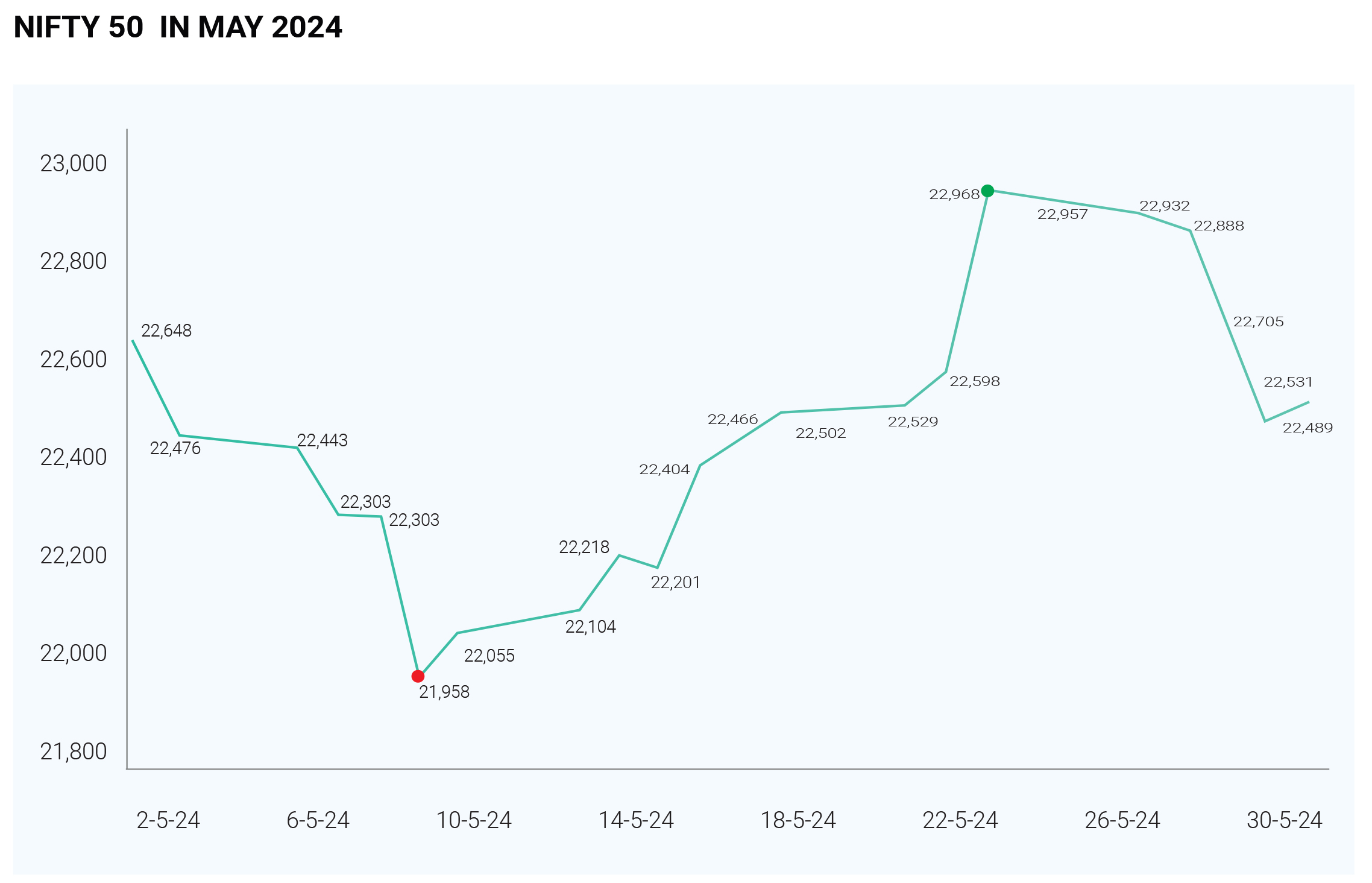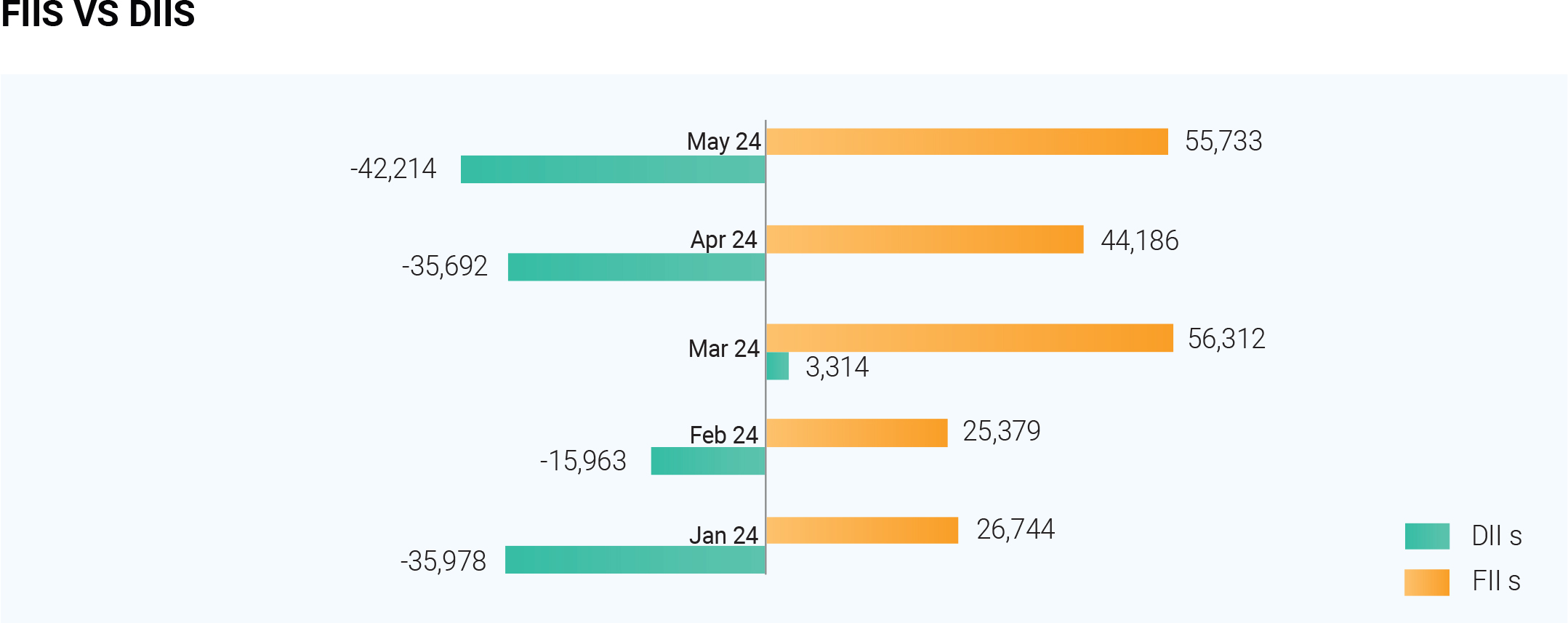The Indian stock market concluded May 2024 on a lacklustre note, with major indices like Sensex and Nifty consolidating within a narrow range. The broader market also lacked momentum, reflecting investor caution. On May 30th, Sensex closed at 74,095.92, down 0.55% (407 points) after opening marginally lower (0.18%) at 74,356.90. Nifty 50 hovered around the 23,000 mark but ended the month slightly below 22,900 with a minor loss.

Many factors contributed to the muted performance like
weak global signals, volatility of F&O monthly expiry,
escalating geopolitical tensions in West Asia, ongoing
election jitters, and lastly the negative advance-decline
ratio and stock-specific corrections indicated the weak
market breadth, indicating a lack of widespread
participation.
As the FIIs Pull back domestic investors supported the
market. Despite a positive underlying trend, the Indian
market witnessed significant foreign selling in May
2024.This aligns with the "Sell in May and go away"
adage, with FIIs offloading Rs. 25,600 crore worth of
Indian stocks. This shift likely reflects portfolio
rebalancing ahead of the upcoming Lok Sabha elections
results. FIIs dramatically increased their short positions
on May 30th, jumping from 5,000 contracts to a

staggering 2.97 lakh contracts in a single day. Concurrently, their long positions shrunk by 80%, representing the largest net outflow since January 2024. This selling extends beyond India, with FIIs pulling funds from other Asian markets as well. Domestic institutional investors (DIIs) provided counterweight to the FII selling, consistently buying Indian equities and upholding market support. The reason why FIIs are pulling back can be attributed to strong performance of Chinese stocks, increasing US bond yields, relatively high valuations of some Indian sectors, like financials and IT, and lastly disappointing earnings reports in certain sectors. However, the outlook is not entirely bleak. A stable outcome from the elections, coupled with India's strong GDP growth, manageable inflation, and potential for a pause in monetary tightening by the RBI, could entice FIIs to return as buyers.

Large-cap stocks largely followed the broader market
trend, rising by about 0.18% on May 30th, nearly matching
the Nifty 50's performance. The real estate and utilities
sectors were the key drivers of gains within large caps.
Notably, the real estate sector has delivered impressive
triple-digit returns year-to-date (FY24). Mid-cap stocks
emerged as the outperformers, with the Nifty Midcap 100
index surging by a significant 59% in FY24. Small-cap
stocks also witnessed strong gains, with the Nifty
Smallcap 100 index climbing 69% year-to-date.
May 2024 offered a mixed picture of the Indian economy.
While positive signs emerged in sales revenue and GDP
growth, profit performance and political uncertainty
presented challenges. Sales revenue growth in Q4 was
encouraging, exceeding growth in previous quarters. This
upswing, largely driven by the banking sector, suggests a
pick-up in business activity. Despite the sales growth,
profits lagged due to cost pressures and banks facing
difficulties in thinner markets. A bright spot was Q4's GDP
growth of 7.8%, exceeding market expectations of 6.5%.
This indicates a robust and growing economy. Current
political landscape likely caused investor caution and
contributed to market volatility.
The Indian bond market enjoyed a welcome rally in May
2024, fueled by a combination of positive domestic and
global factors. A stronger fiscal position at home, coupled
with reassuring news about inflation abroad, boosted
investor confidence. However, concerns lingered about
the potential for rising U.S. yields to dampen the positive
momentum. The rally saw yields on Indian government
bonds (IGBs) decrease by 12-15 basis points (bps).
Notably, the benchmark 10-year yield dipped below the
psychologically important 7% mark, a boon for investors
seeking stable returns.
The Indian rupee enjoyed a two-month high in May 2024,
closing at its strongest level since March 19th. On May
26th, it settled at 83.0975 against the U.S. dollar. This
appreciation was influenced by global factors, including
movements in U.S. bond yields and the Federal Reserve's
monetary policy decisions.
Gold prices in India, however, presented a mixed picture in
May. While the price of 10 grams of 22-carat gold
fluctuated throughout the month, it closed at Rs. 67,888
on May 31st, compared to Rs. 65,908 on May 1st.
Analysts anticipate a potential rise in gold prices in the
coming quarters, driven by factors like global economic
uncertainty and the upcoming festive season, which
typically sees a surge in gold demand.
In May 2024, crude oil prices experienced a decline, as on
May 28, 2024, the Brent crude oil price stood at $84.23 per
barrel, compared to $79.83 for WTI oil. The Brent July
contract closed at $81.62 per barrel, a decrease of 24
cents or 0.29%. Factors contributing to the decline in oil
prices includes – health of global economy and oil
demand, easing Middle East tensions, sluggish oil
demand and expectation of prolonged high interest rates.
However, OPEC+ is expected to extend its ongoing
voluntary output cuts of 2.2 million barrels per day at its
upcoming meeting, which could increase the price.
The Indian markets in June 2024 are expected to be
influenced by several factors, including the outcome of
the general elections, monetary policy decisions, and
global economic trends. A stable government, cautious
monetary policy, and positive global economic trends
could lead to increased investments and a positive
market outlook.

